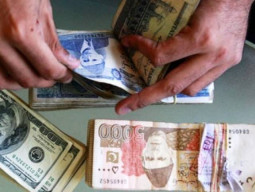
SITTWE: Barbed wire and armed troops guard the Muslim quarter of a violence-wracked city in western Myanmar, a virtual prison for the families that have inhabited its narrow streets for generations.
The security forces outside the ghetto in the Rakhine state capital Sittwe are not there to stop its residents leaving - although few dare to anyway - but to protect them from Buddhist mobs after an outburst of sectarian hatred.
In the nearby city centre, life has regained some semblance of normality since the authorities imposed a state of emergency in June in response to Buddhist-Muslim clashes that left dozens dead and tens of thousands homeless.
But inside the tense enclave of Aung Mingalar, hundreds of families from the Rohingya Muslim minority group say they are living in fear for their lives.
"Rakhines will attack us today," one man told AFP at Friday prayers last week.
The same evening groups of Rakhine Buddhists - who have also accused the Rohingya of attacks on their communities - gathered outside the barriers, prompting troops to fire warning shots and sparking panic inside.
On three separate days earlier in the week, hundreds of ethnic Rakhines - sometimes led by Buddhist monks - had marched near the perimeter demanding the "relocation" of Aung Mingalar.
Their shouts were clearly audible by people within the ghetto, who could only imagine what was happening outside.
"In my opinion, living in the Sahara desert in Africa would be better than living in this situation," said 28-year-old Mohamed Said, tears welling in his eyes.
"We cannot suffer anymore. We have lost everything but our lives. We are human beings as well," he said.
Between 3,000 and 8,000 people are thought to live in an area of roughly 0.5 square kilometres, where no traffic circulates and almost all shops have been shuttered.
Supplies of food - mainly rice - are provided by the authorities and some benevolent Buddhist locals, forced to deliver aid discreetly for fear of fanning local resentments. But there is not enough to eat.
Some Rohingya have dared to breach the barriers - which vary from bamboo and barbed wire to simple security cordons - hiding their faces under hoods to prevent people identifying them.
But most people have not ventured outside in four months.
"This bamboo fence is like a psychological barrier, symbolising the fear that separates the two worlds," said Chris Lewa, head of the Arakan Project, which campaigns for Rohingya rights.
Calls are growing for the Muslim quarter to be moved.
"If the Aung Mingalar quarter stays in the city centre, the problem will get worse," said Nya Na, a leader of a monk association.
"I don't want the two communities to fight. It is risky for them to stay."
The stateless Rohingya have long been considered by the United Nations to be one of the most persecuted minorities on the planet.
Viewed as illegal immigrants from neighbouring Bangladesh by the Myanmar government and many Burmese - who call them "Bengalis" - they face tight restrictions on their movements and limited access to employment, education and public services.
More than 50,000 Muslims and up to 10,000 Buddhists are thought to be displaced across Rakhine state, where people from both communities were forced to flee as mobs torched whole villages.
Segregation, already imposed on many of the 800,000 Rohingya living in western Myanmar, has become widespread since the unrest, with many fearing the divide will become irreversible.
Muslims have been left particularly deprived, with thousands living in squalid camps on the edge of Sittwe, separated from the Buddhist population and with scant provisions.
Muslim men and women whose beards and headscarves were common sights just six months ago have largely disappeared from sight in the city centre.
The segregation recalls South African apartheid in the 1980s, "but worse" because the Rohingya are unable to leave their camps, Lewa said.
"Freedom of movement was always an issue for the Rohingya, but it is an extreme restriction now," said Sarnata Reynolds, of aid group Refugees International.
"Unofficially there seems to be widespread agreement that the camps will likely be there for three years or more, and that it might be the beginning of a permanent segregation."
The UN, which has been active in the region for decades, is more hopeful.
"We are informed by the government that it is for the purposes of bringing the unrest under control, that this is a temporary separation, not a segregation," said UN country chief Ashok Nigam.
But even if the camps are closed and the barbed wired surrounding Aung Mingalar taken down, the fear is that the distrust will endure between communities that once lived side-by-side as neighbours.
"As long as Bengali people are here, there is fear, disharmony and anger. I wish they would stay away from here," said 60-year-old Buddhist San Win Phu, sheltering at a local monastery.
COMMENTS (19)
Comments are moderated and generally will be posted if they are on-topic and not abusive.
For more information, please see our Comments FAQ














































This ugly riot started after a certain Rakhine woman called Ma Thi Da Tway had been raped allegedly by three Rohingya men. For me, there was no such rape incidence at all. Consider the following points. 1) There was no single eyewitness who had seen the rape taking place. 2) The main alleged rapist of the three called Htet Htet was not a Rohingya but a Rakhine who used to practice Islam. He had not had any connection with the alleged raped victim called Ma Thida Twe. 3) According to the medical reports which government didn’t disclose to the general public, Ma Thida Twe was not raped but robbed and killed. 4) Authority carried out a closed-door court proceeding after Htet Htet, right during first trial in the court, had denied committing such a rape. 5) Burma’s prisons are known for killings, not for suicides. How could a person who had been beaten so much so that his legs and other parts of body below the waist became paralyzed commit suicide? One must be able to stand on somewhere in order to get himself hanged, which Htet Htet could not. If he didn’t hang himself, then how did he commit suicide? Burmese authority didn’t disclose any information upon their court proceedings and how he had committed suicide to the public. There are many more gaping holes in the conspiracy. It is up to you find out who have conspired such as an ugly violence against an already crippled community in Arakan and why!!!
Budhists are most generous and peace loving people. They believe God is not required to live a spiritual life. The problem in Rakhine is not religion. It is infiltration, land grabbing and claiming rights by Rohingya Muslims from Bangladesh. Ethnic Muslims are living peacefully in other parts of Burma. Bangladesh Govt must repatriate Rohingyas back to B'desh.
Assam in India have same problem and not religious persecution.
What about the muslims of Karachi? I understand on an average, 8-10 are killed every day. What is the count of Shias, Ahmadis, Balochistanis, Hazara, Hindus and Christians? Should'nt Pakistanis worry about their own first?
@Muhammad Yaqub: Are these Muslim governments not criticized by the Muslims they govern? The point is that Muslims are being persecuted by Muslim governments because they are subjects. They are being persecuted in Myanmar because they are Muslims.
I dont agree with the notion that we have no right to complain.
If we recognize that we treat our minorities badly and admit it, we can criticize other as well.
Sorry but the Governments of Muslim countries are too busy killing other muslims in Libya, Lebanon, Syria, Iraq, Pakistan etc.etc.
@ashish: @Aryabhat: @A. Khan: going by your logic, it means Americans,Indians, Israel does not have any right to condemn anything wrong in this world because they themselves have killed thousand of Iraqis, Kashimiris, Palestine's !!!! Shame on such people who have gone to the lowest ebb of humanity.
@love humanity:"Wrong doings of few Pakistanis in no way revoke rights of majority of (piece loving) Pakistanis to condemn wrong doings of non-Pakistanis!", But the problem is there are very few Pakistanis who do not commit wrong, other wise majority of them are fanatics and religious bigots. For whom religion comes first and humanity next. Rgds P
@ a. Khan, raw and g. Din:
Why can't Muslims complain? It is their duty to protest against cruelty toward any human beings. These complaints also establish that bigotry and brutality are committed in the name of all religions: buddhists in myanmar and thailand, christians in europe (remember bosnia), jews in palestine, muslims in pakistan and, as raw and g. Din seem to suggest by their comments, hindus wherever they may be....
They should come to Pakistan and settle in Islamabad and Defence of other cities at the cost of Railway Minister.
The respondents to the article, both Believers and Non Believers have responded in unison, This goes on to tell why west thinks about them the way they do...
Wrong doings of few Pakistanis in no way revoke rights of majority of (piece loving) Pakistanis to condemn wrong doings of non-Pakistanis!
Shame on those who are causing sufferings and miseries to Rohingya Muslims!
"“In my opinion, living in the Sahara desert in Africa would be better than living in this situation,” said 28-year-old Mohamed Said, tears welling in his eyes." That may be the best solution! "We are human beings as well,” No, You are Muslims first who believe they are the chosen ones and are entitled over other "mere" human beings. That is what got you into this situation. Had you thought of yourselves as human beings first, others would have empathized with you!
We ourselves here in Pakistan are scared you just never know who may have an enmity or jealousy with you & impose Blasphemy law on you . This is Pakistan now & for the rest its on the news daily
pakistani people have no right to complain. first take care of your own minorities.
Suggest you look a bit closer - at Hindus in Sindh, Sikhs in KP, Hazaras in Balochistan, Shias in Parachinar.......
Improving their condition is something in GOP's powers. And that may give some moral grounds for you to then speak about Rohingyas. Else it smells of Hypocracy!
@ A. Khan
absolutely right.
We cannot complain about suffering of Muslim minorities in other countries when our own ethnic/religious minorities are so badly treated.